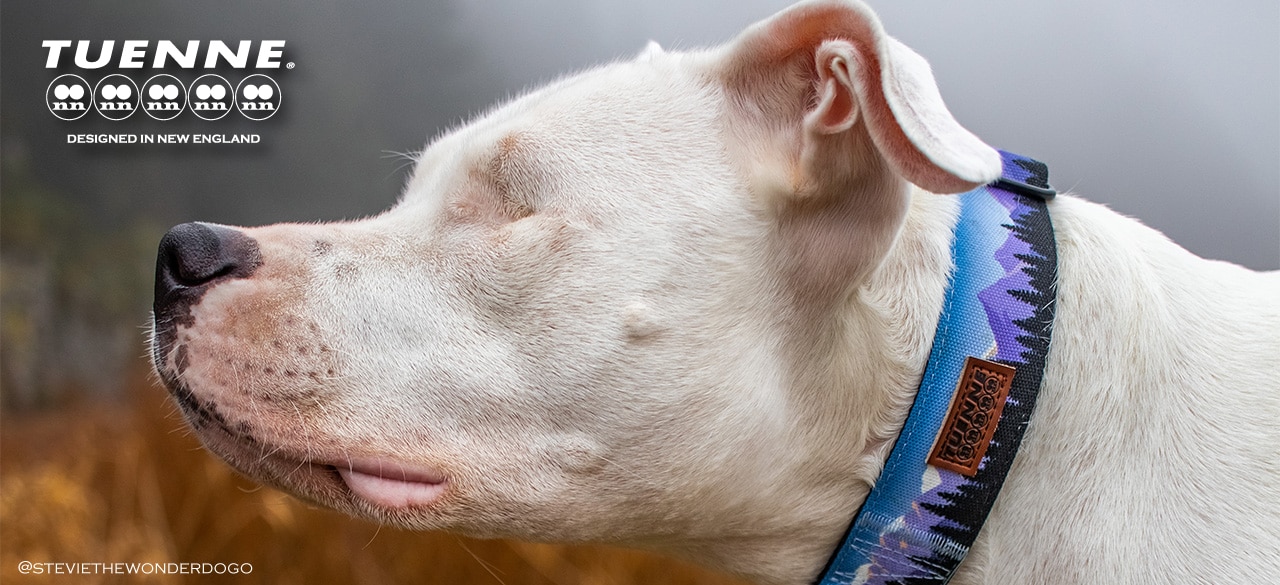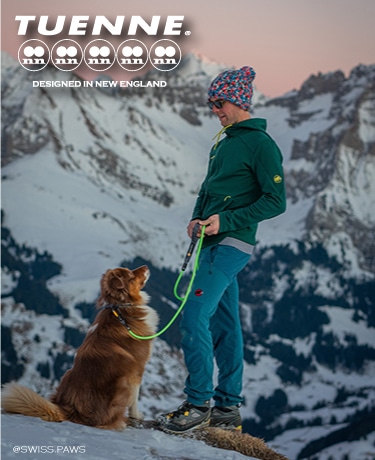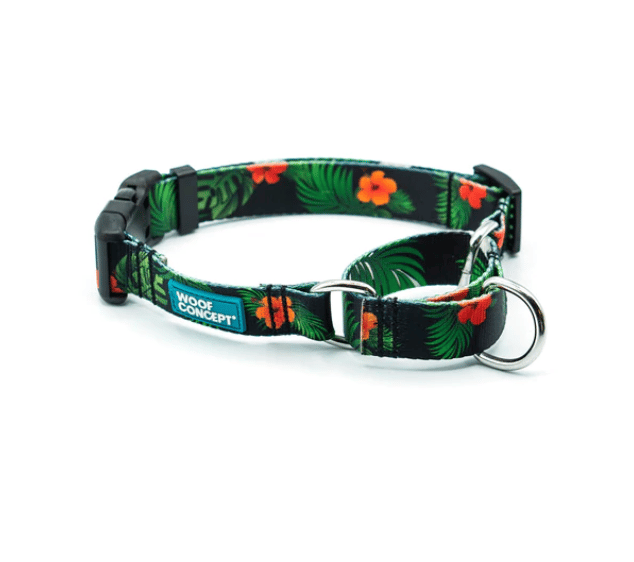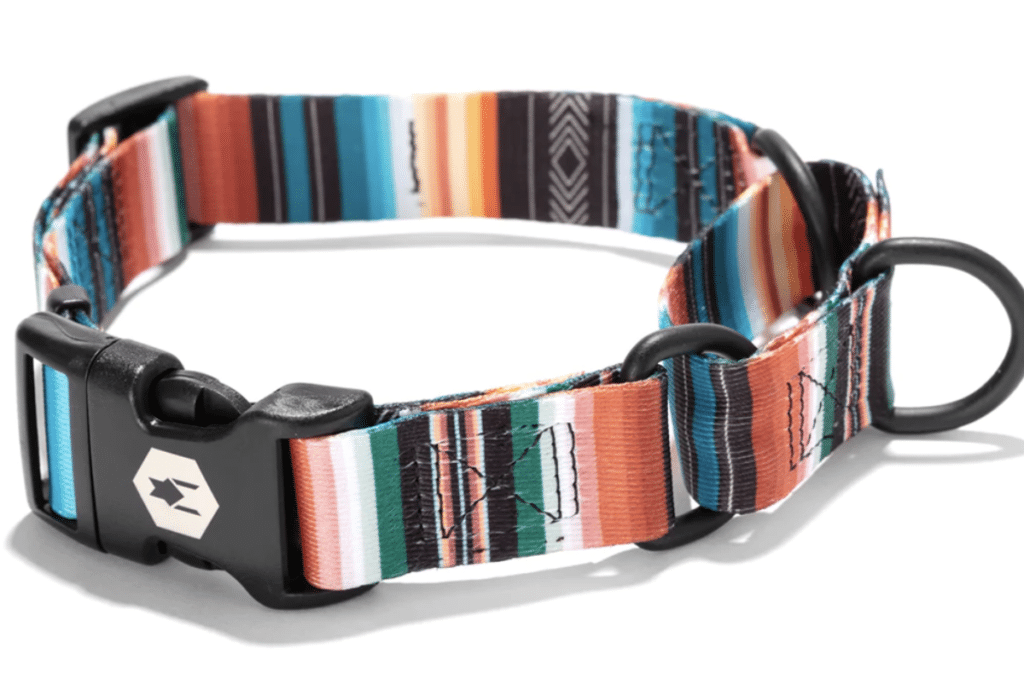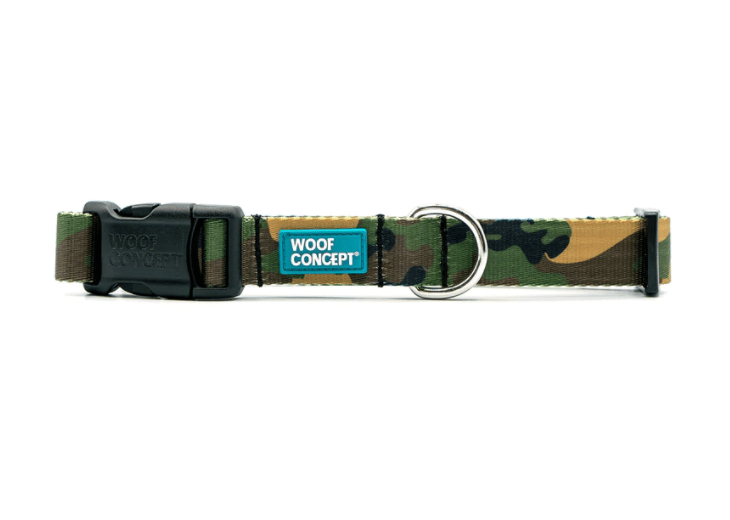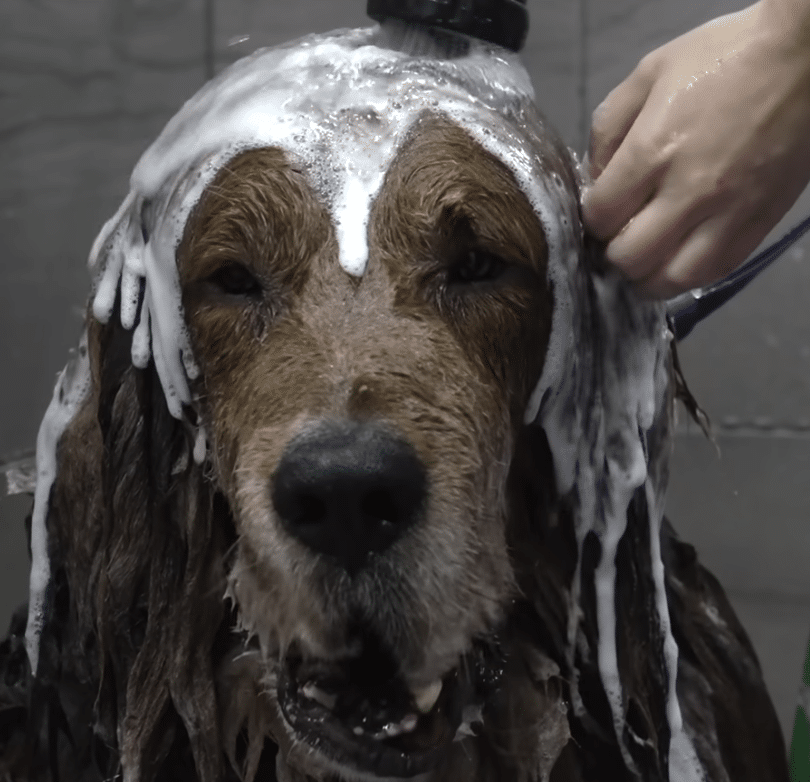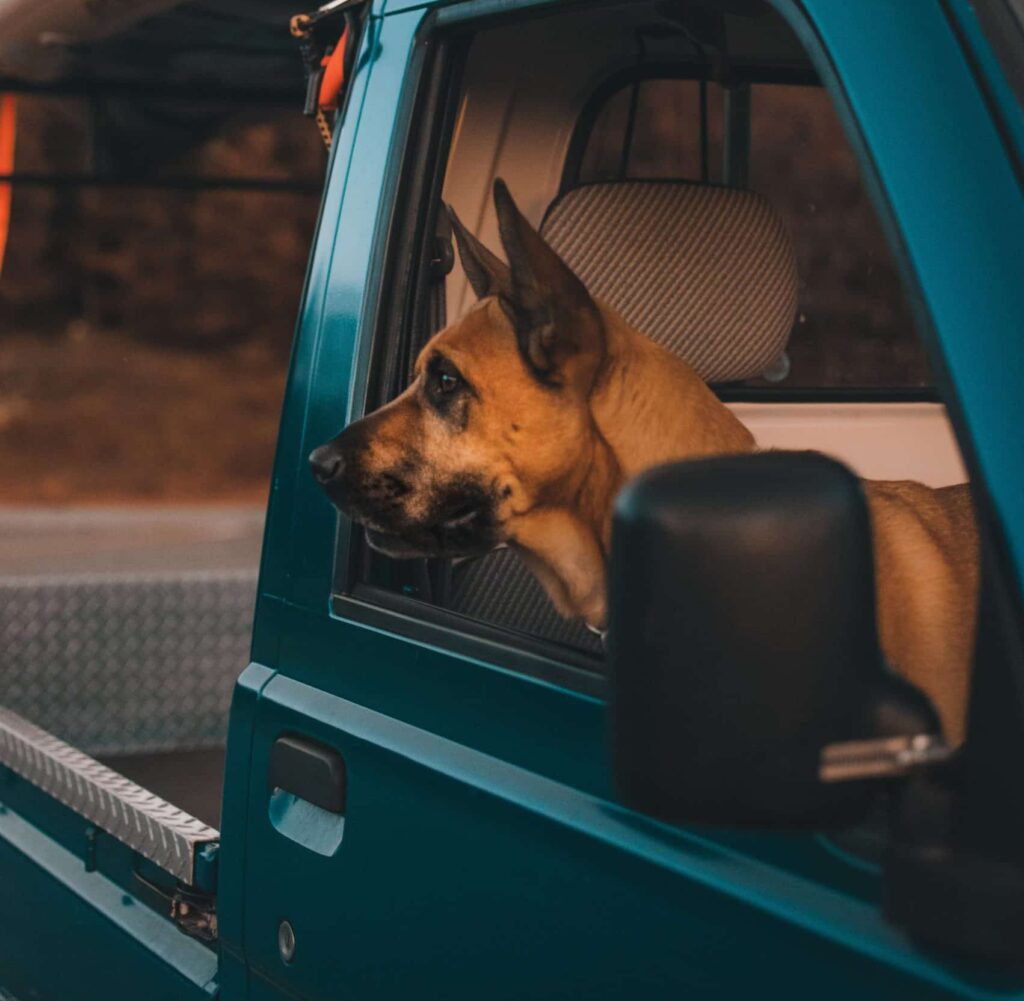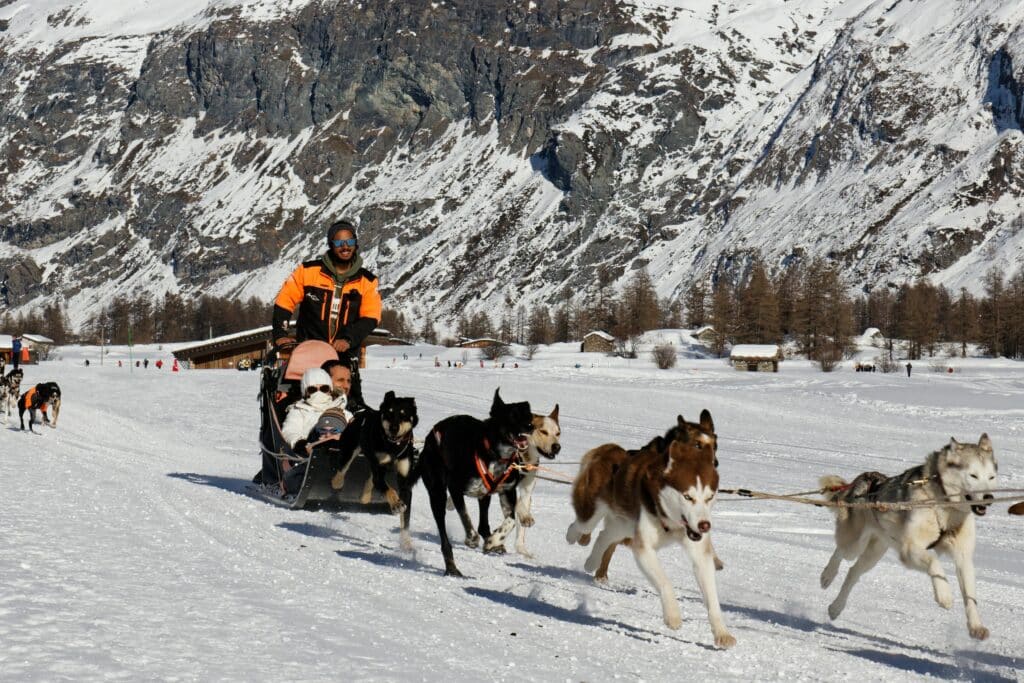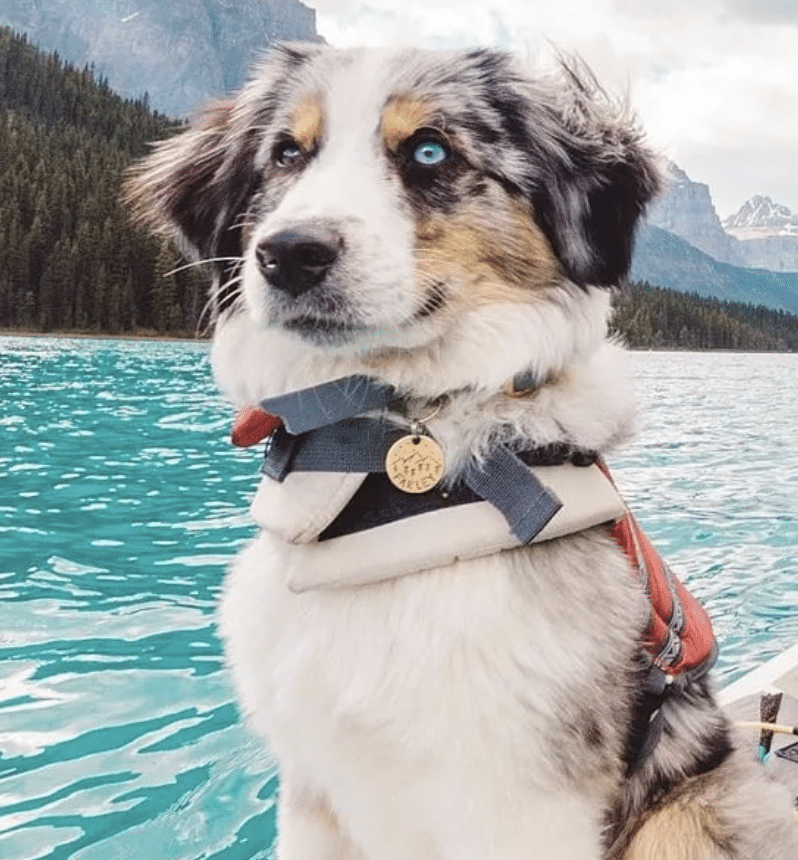It’s All in the Eyes
When it happens, you just know. Your heart swells and you are overcome with feelings of joy, peace, and a strange sense of nostalgia, as if you’re already yearning for the moment to be new once more. For many of us, it has become the most reliable evidence that we are loved. No, we aren’t talking about the embrace of our partners or even the encouragement of friends and family. We are describing the mutual, often intense gazing that we share with our dogs. We use the term “gazing” because that is precisely what’s taking place. It isn’t a stare, but rather a deeper, more patient effort to reach out—a penetrating look that conveys invitation, affection, and earnest commitment to knowing who we really are. Even from across the room, it feels like being held. Through our years of studying the human-canine bond, we still find ourselves mesmerized by these moments with dogs, and often wonder what our reciprocal gaze feels like to them.
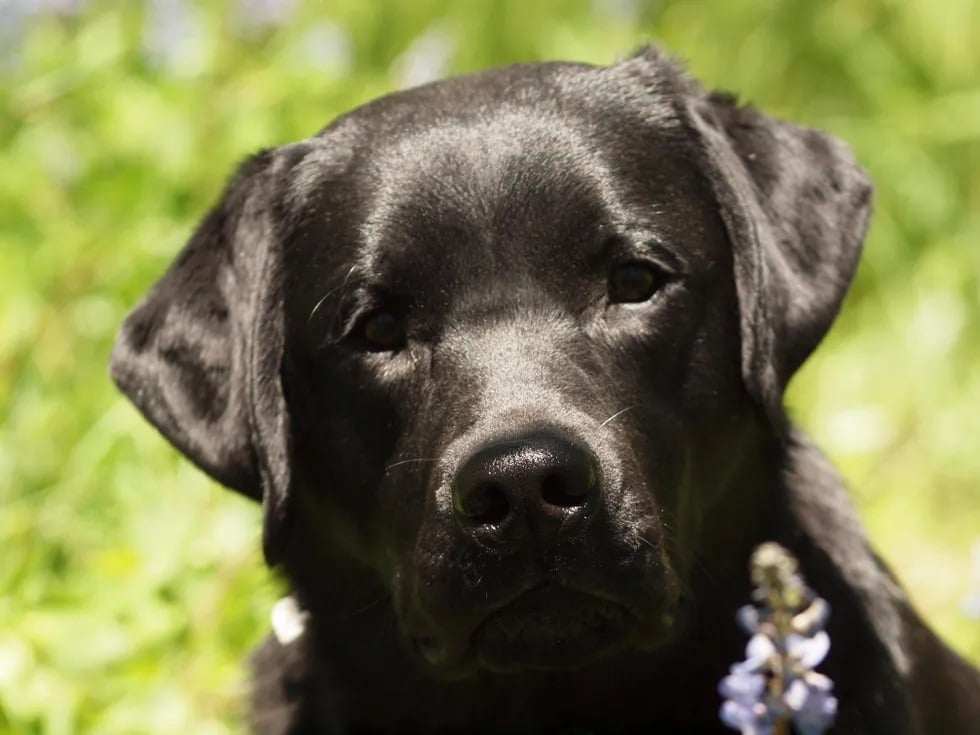
Samara, a working therapy dog at the University of Denver who lives with Philip Tedeschi
Photo by Philip Tedeschi
Given that you’re reading this in Love, Dog, you probably know how it feels to have a dog look at you like that. As humans, many of us bond emotionally when we make eye contact with others. This type of intentional and sustained gaze is a universal offering of vulnerability, presumably holding meaning for both parties. Canine researchers Dr. Miho Nagasawa and her colleagues found that this interspecies communication parallels the gaze-mediated connection we see in close human relationships, including the attachment between mothers and infants. Their 2015 study determined that mutual gazing between people and their canine companions activates the oxytocin system for both species. The release of oxytocin (or the “love hormone”) in humans has been found to increase and/or maintain the following:
- Support, affiliation, and affection in relation to others
- Emotional safety and capacity for trust
- Attachment security
- Optimism and positive social perspectives
- Stress and anxiety management
Furthermore, studies suggest that increased oxytocin makes us more approachable and easier to like, leading to the formation of mutually beneficial connections.
The degree to which dogs are connected to us is astonishing, and while the evolutionary continuity of our shared relationship goes a long way toward explaining the depth of the human-canine bond, it doesn’t fully unravel our unmitigated, head-over-tails love affair.
***
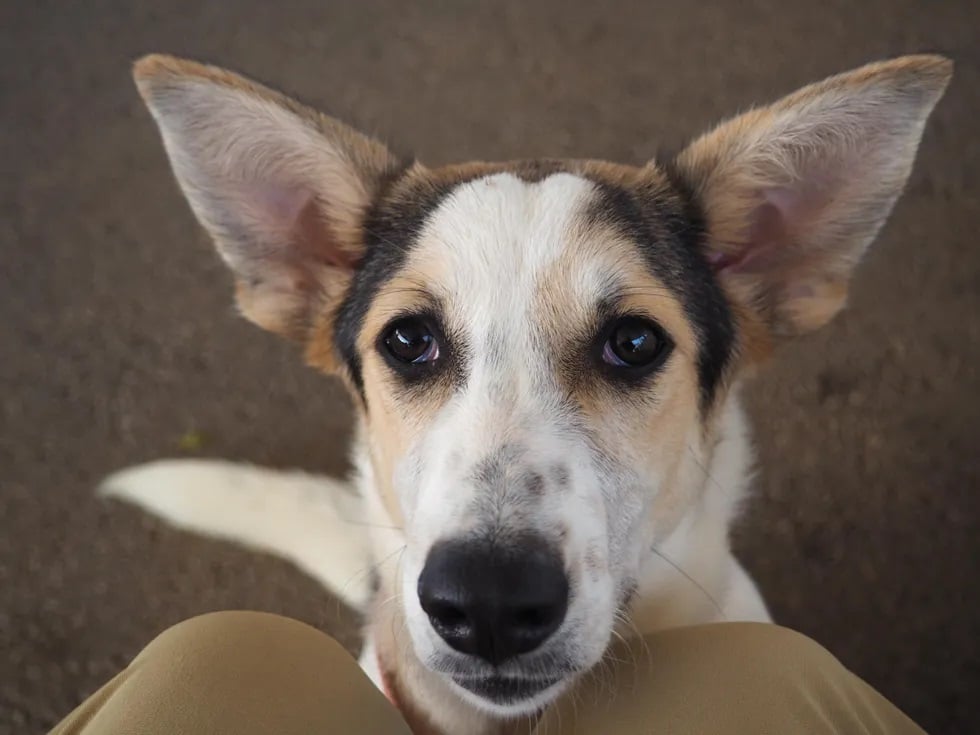
Unnamed dog at u0022Let the Animals Live Shelter,u0022 Tel Aviv, Israel
Photo by Gabi Shani
Together on a Shared Path
Relationships with dogs stay with us for a lifetime, break our hearts when they end, and remind us of what matters most. In the U.S., you can find a dog in two out of every three homes, with 900 million dogs living across the globe. In our work, we are always seeking to determine the elements that comprise this profound mutual affection. For example, how exactly did we become friends in the first place, offering such deep sources of companionship to one another, and how did these sustained friendships transition from a need to survive to a desire to connect? How did dogs grow into the vital family and community members they are today?
We have all heard of the early human communities of hunter gatherers whose daily lives faced unimaginable hardship and danger, thereby requiring them to devise efficient ways of protecting themselves and gathering food. It’s likely that these individuals encountered wild canines (Canis lupus) and, through incremental interactions that tested each party’s intentions, learned to co-exist and rely on one another for essential resources. Through time, the mutual trust that developed between species provided humans with safety when in the presence of dogs. Surely, dogs physically shielded people from peril, but they likely also increased their sense of neuroceptive safety—a concept originally conceived by Dr. Stephen Porges to describe how the human brain assesses whether situations are safe or threatening. With their superior sensory capabilities in hearing and smell, dogs often serve to alert people of potential dangers hiding in and out of plain sight. At the same time, observing a known dog who is calm or playfully engaged disenables our defense mechanisms and allows us to know, however subconsciously, that “the camp is safe.”
The intersection of our existence on earth has allowed dogs to become sensitive to nuances in human behavior and emotion, with some saying canines are now the smartest social animal in regard to understanding people (even surpassing other primates). As pups, dogs seem to naturally respond to human voices or gestures, including directing their attention to where a person is pointing or staring, finding hidden treats and toy treasures, and even accurately reading subtle facial expressions. This tendency to affiliate with us by using modes of relational communication can allow for immediate bonding to take place in human-canine pairs and families. Furthermore, the capacity of dogs to exhibit many of the same cognitive capabilities that define how our own species attempts to understand one another suggests that they may want to know us more deeply than any other animal, including humans.
Having dogs ever by our side has become increasingly desirable, all while making humans a more secure, agile, and successful species. But what about “all the feels” we experience in their presence or the lessons they have instilled in us over time? And how do we know they feel the same way about us? You may have found yourself wondering (as we have), “Is my dog ‘giving me the eyes’ because she loves me or is she simply here for the kibble?” What seems to be clear is that domestic dogs, unlike their wild counterparts, generally view people as reliable, even treasured partners with whom to face the complex world. In fact, when given the choice to spend time with other dogs, even their best canine friends, domestic dogs will often elect human companionship. Wolves, on the other hand, neither expect nor wish to have humans as roommates or family members—in case this isn’t plainly obvious, we wouldn’t recommend trying to gaze into the eyes of a wolf.
This choice to be together is not one-sided; individuals frequently prioritize time spent with their dogs over the company of people, even significant others. Likewise, we have learned reciprocal and sensitive ways to communicate with them, through advancing our understanding of the special meanings behind canine vocalization and body language. Healthy human-canine relationships are symbiotic, offer mutual benefits, and require a deep expression of commitment from both species to living with one another. They resemble that of a soulmate or, as Merriam-Webster defines it, “a person who is perfectly suited to another in temperament.” Given accounts suggesting that we are better at selecting our canine companions than our human partners, perhaps an expansion of this definition to include dogs and other non-human animals is warranted. Indeed, the average dog in the U.S. receives seven gifts per year, with Valentine’s Day outshining all others as the largest gift-giving holiday for our canine soulmates.
***
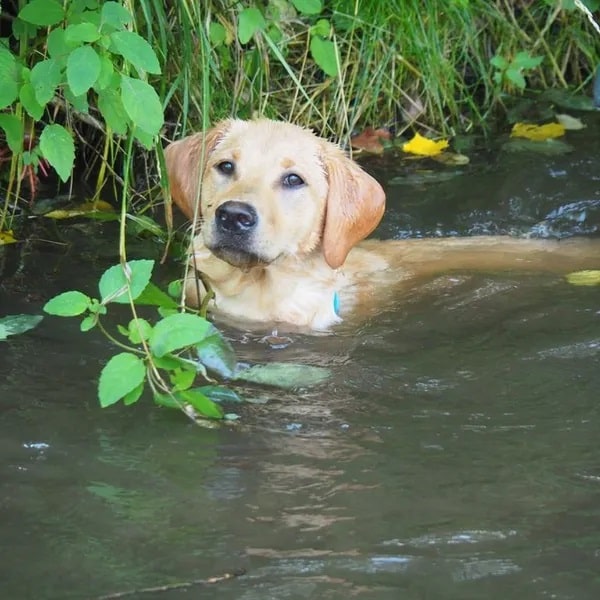
Tedeschi’s dog Juniper
Photo by Philip Tedeschi

Juniper at Palmer Lake, Colorado after a big snow storm
Photo by Joe Brown
Keeping it Real
What makes our bonds with non-human animals so transformative is the freedom we feel to be wholly and unabashedly ourselves when in their presence. Scholars often attest to the unique capacity of dogs to love us without judgment. With them, we feel at ease to be honest with our emotions; to be “too much” one minute and hushed or contemplative the next. There is no need to meet the unobtainable expectations that so often dictate who we feel we are “supposed to be.” Connecting with dogs—whether through quiet gazing, leaning on or against one another, or playing a rip-roaring game of fetch—represents a distinctive outlet for us to be genuine.
Authenticity in many of our relationships often feels out of reach. According to researcher and fellow social worker Dr. Brené Brown, the pressures of being “perfect” and projecting unwavering strength can prevent us from the sheer relief of being who we truly are. If you have seen Brown’s popular 2010 and 2012 TED Talks, then you know how much she believes in the power and challenging nature of vulnerability. That is, to be intentionally vulnerable or to allow ourselves to be seen is essential for our well-being, but also requires courage to overcome the bedrock of our insincerity—shame. The impacts of feeling ashamed not only keep us hidden (both literally and figuratively), but may also lead to anxiety, depression and, ultimately, an avoidance of social connection deeply rooted in fear of rejection.
It’s easy to reflect upon the rituals we perform every day in an effort to avoid the pain that comes from harboring shame. How many of us have scrubbed our floors clean just before a guest arrived? Or rehearsed a thought in our heads before feeling confident enough to share it out loud? Fear of ridicule from friends, foes, and strangers alike will forever keep the diet industry in tip-top shape. When we are with dogs, however, self-conscious habits like these seem so needless they barely even come to mind. In fact, dogs might very well prefer an untidy house, where floors are theirs for the snoozing. Hearing their person speak off the cuff in a particular, affectionate babble may be just what they need to know all is well. And what dog doesn’t appreciate ample access to rich foods by way of table scraps? With dogs, we are accepted, even celebrated, for exactly who we are.
***
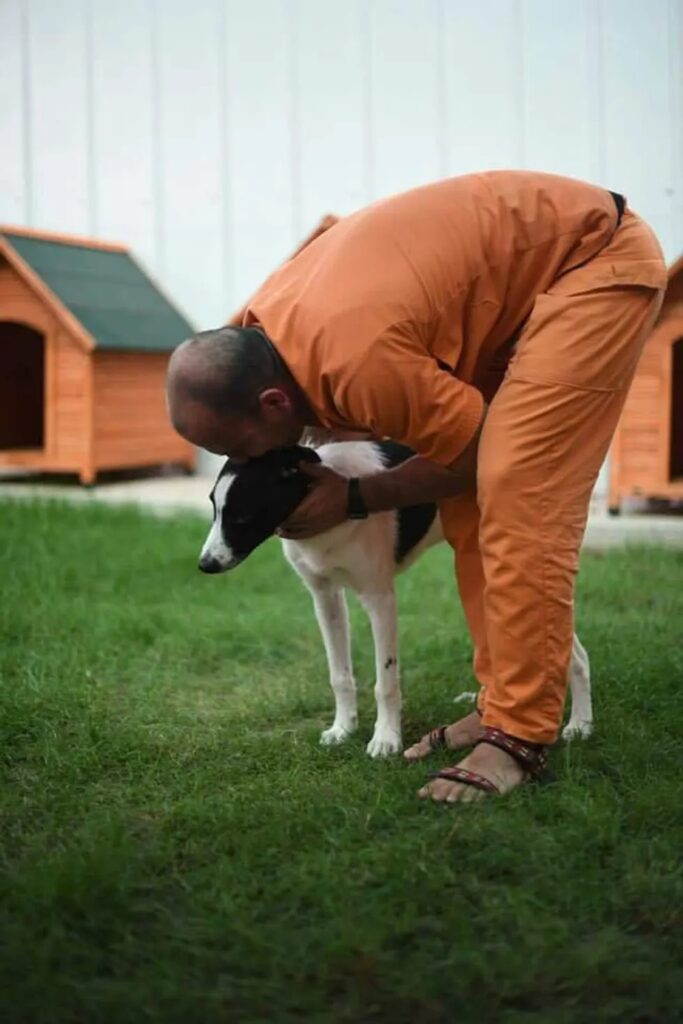
Inmate in Dog Program at Harmon Prison, Northern Israel
Photo by Gabi Shani
Safe and Sound
The ability to feel safe together is central to understanding why human-canine connection is so primary in our lives. The reliable and virtually boundless affection we receive from dogs opens opportunities for trust so often missing in other relationships, as well as in society more broadly. And when we feel secure in their love for us, it takes less effort and bravery to be vulnerable. We can trip and fall with abandon. We are free to show unreserved tenderness. We can reveal secret, unsightly aspects of ourselves knowing they will still think the world of us. At the end of a day mired with self-doubt, dogs make us feel worthy when we come through the door. An exuberant tail wag is like walking into the purest and warmest of hugs, offering us a refuge to be our authentic selves. For many, including unhoused and socially marginalized individuals, their dogs are their home—to lose them would mean losing their family, their warm and safe haven, their very lifeline when faced with immense hardship.
Growing research indicates that interacting positively with dogs offers people myriad benefits, including increased levels of oxytocin, as well as improvements in mood, stress and anxiety, empathy and socialization, physical health, and trauma symptoms. This is most certainly due to their relatively unique ability to provide people with direct and indirect social support, which helps play a pivotal role in the recovery from many physical and mental health-related challenges. Because of their remarkable intelligence and trainability, affable nature and noted sensitivity to human behavior and emotion, dogs are increasingly included in human services through their work as therapy, service, and emotional support animals. Having a therapy dog visit you in the hospital or take part in a counseling session is now commonplace, while people with disabilities and/or mental health conditions often rely on the assistance of dogs to engage fully and independently in everyday life. The fields of anthrozoology and what our institute refers to as “human-animal-environment interaction” are growing at a rapid pace, signifying a fundamental change in how people view, value, and connect with the living world.
In our 2019 book, Transforming Trauma: Resilience and Healing through Our Connections with Animals, we and our fellow authors explore the various roles that dogs and other non-human animals play in trauma response, recovery, and prevention. Chapter after chapter, a common theme emerged: feeling safe is integral to healing, especially for people with trauma histories who live so much of their lives with a sense of mistrust and shame. The comfort and physical security that dogs offer can reduce anxiety and hyperarousal, thereby helping people with post-traumatic stress regulate their emotions, focus on the present rather than re-experience the event(s), and feel confident when engaging with the social world. In therapy, dogs have also been shown to facilitate trust between clients and therapists (a key to successful treatment), as well as provide a rare opportunity for relaxation and focus through physical touch.
People, especially those who have experienced trauma, frequently engage in a neuroceptive, subconscious scanning of their environment for indicators of threat, such as other people’s body posture, vocal intonations, and physical health indicators. Much like our early human ancestors, when we are able to observe another being in a relaxed and thriving state, our brain communicates that there is nothing to fear here. This is why witnessing a loving relationship between a therapist and a well-cared for therapy dog is so essential; through these types of interactions, a person with trauma can see a dog who is embraced for who they are, even if they engage in “naughty” behaviors or struggle with learning to sit and stay. In other words, the person can begin to view the therapist and therapy as inherently safe, and to believe that they too can count on receiving compassion during the recovery process. They may even begin to feel safe in the world again.
***
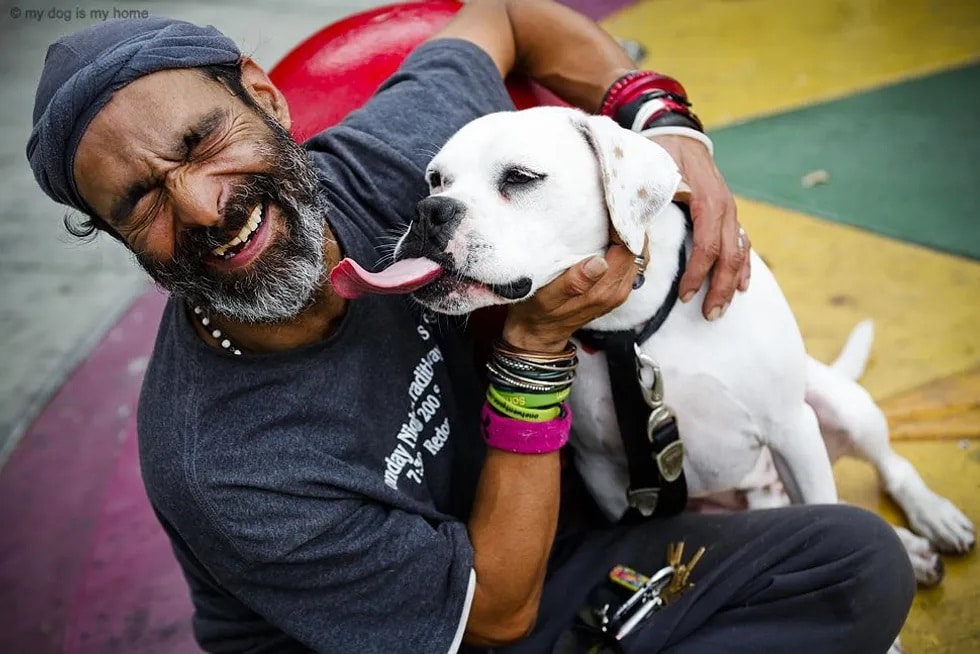
Photo attributed to u0022My Dog is My Home,u0022 first printed in the LA Times
Photo by Unknown
Love in the time of COVID-19
Over the past year, feeling unsafe and even traumatized went global. Fear of contracting and transmitting a deadly virus caused us to socially distance from, or grieve, our loved ones; lose or adapt our livelihoods; and pause many of the activities that give our lives meaning. The messages we received on how best to care for ourselves and others were unclear, leading to confusion and heated debate across political lines. For many, this sense of mistrust was heightened by the tragic deaths of BIPOC individuals at the hands of police officers. The protests that followed stemmed from the pain of insidious trauma and the need to be heard after countless lifetimes of systemic racism and oppression. They also led to calls for broad scale accountability and improvements to virtually every system, as well as vehement backlash from those with dissenting viewpoints. In short, it is fair to say that most of us—especially people of color and those experiencing economic uncertainty—felt at risk, with many fearing a lifetime of hardship as a result of the past sixteen months.
It may not be surprising, then, that dogs played an even more outsized role in supporting their people during the pandemic. Without our usual social contacts and activities, dogs, as always, were there for us to bolster our spirits and provide companionship, solace, and purpose. For those fortunate enough to work from home, commutes were shortened to the twelve feet it took to walk from a bed to a makeshift desk. As such, dogs became our office mates and/or “social distancing companions,” buffering us from the effects of loneliness, cabin fever, and fatigue. They also seemed to be genuinely thrilled by the changes in our schedule, happy to have us all to themselves.
At the beginning of quarantine, people with and without pet dogs engaged in a curious canine-based bonding ritual: howling at the moon each night. Whether it was to show support for the healthcare workers who were risking their lives to save ours or to declare fervently that we were still here (or both), it is interesting that we used the doleful cries of dogs and wolves to communicate our aloneness. Surely, it was cathartic, a way to release the stress we were holding so near. But we wonder if, in some small way, it was also an attempt to “join the pack”—to be more like our dogs and feel closer to them.
Similarly, you likely heard that shelter adoptions soared last year; according to Shelter Animals Count, the adoption rate of dogs and cats increased by up to 9% from 2019 to 2020. While an increase in canine adoptions is encouraging, it is important to emphasize here that these relationships should not be viewed as a one-sided transaction or panacea for all human struggle. Indeed, dogs come with notable financial and practical responsibilities and, like any significant relationship, our bonds with them deserve our attention and consideration. In other words, it takes intentional work (and, yes, a bit of stress) to bring dogs into our lives, and to provide the same security and wholehearted love they give to us.
For far too long, the notion that dogs were capable of any emotion—let alone love—was met with doubt, even scorn. Still to this day, with significant advances in our knowledge of canine behavior, biology, cognition and sentience, some scholars worry that giving too much weight to animal emotion is akin to anthropomorphism (or our tendency to attribute human thoughts, feelings, and intentions to non-human animals and objects). We agree anthropomorphism can have harmful consequences. For example, accusing your dog of “getting even with you” by soiling the rug when you have been gone can lead to inappropriate or abusive punishment tactics (and ultimately sidesteps our responsibility to ensure their well-being). That said, anthropomorphism also allows us to see how we are similar to non-human animals, thereby opening avenues for deeper connection, empathy, and appreciation.
While idling in stop-and-go traffic, you might have seen a popular bumper sticker proclaiming that, “Dogs are the Best People” (or listened to the song by the same name). This simple bit of humorous, anthropomorphic truth hints that dogs are not only comparable to humans, but that they are actually much more adept at what makes good humans great—namely, their honesty, generosity, and radically accepting nature. In his fascinating 2019 book, Dog is Love: Why and How Your Dog Loves You, canine behaviorist Dr. Clive Wynne presents compelling scientific evidence that a dog’s unique capacity to feel and give love (rather than their intelligence, tendency to please, or long history by our side) is truly what gives the human-canine bond its undeniable strength.
***
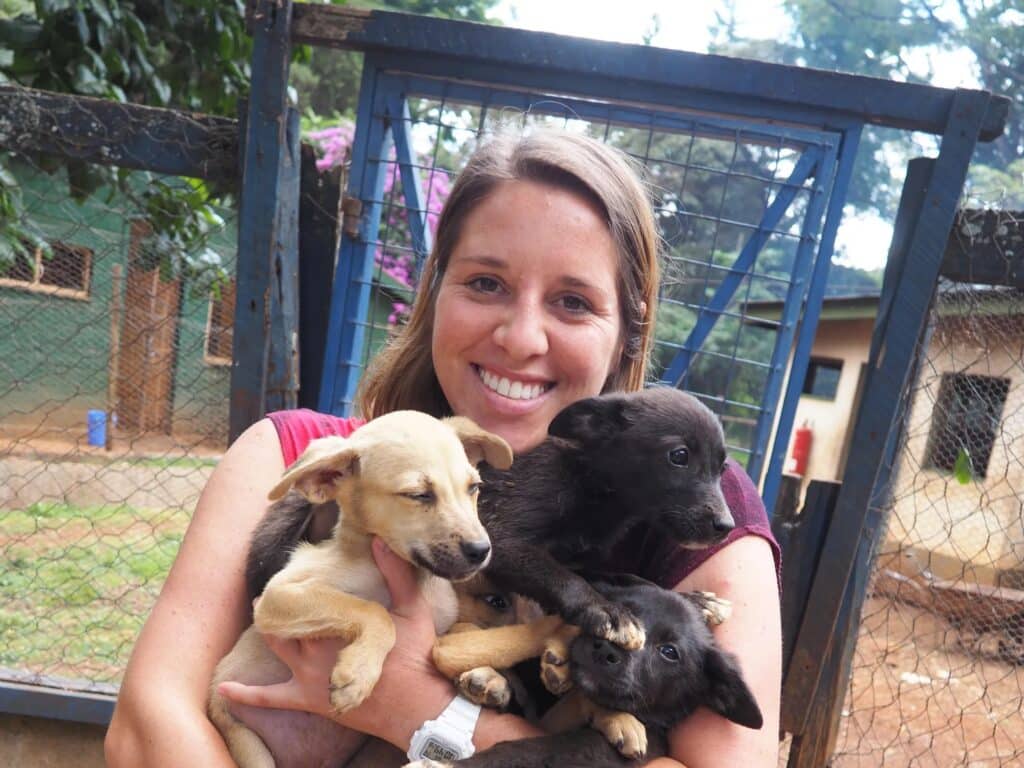
University of Denver Graduate School of Social Work student on a course with Philip Tedeschi in Kenya, Africa at SPCA Nairobi
Photo by Philip Tedeschi

University of Denver Graduate School of Social work student teaching a Humane Education class with Samara
Photo by Philip Tedeschi
Dogs are the Best (and most inclusive) People
Dogs are not only the best people, they are also our best teachers. Taking the time to appreciate their abiding and seemingly genuine love for us, despite our shortcomings, can serve as a reminder of our own capacity for compassion. In the harsh world we find ourselves in, it is often difficult to remember that humane and trustworthy relationships are indeed possible. Social media, for example, practically encourages us to trade joy for comparison, and to mock, lie, and shut our ears to anyone with whom we disagree. To read an empathic comment on Facebook is like a credible Sasquatch sighting—so rare it feels too good to be true. As a result, it has become all the more difficult to have faith in the goodness of our neighbors, especially during periods of ongoing and escalating intolerance like we are now enduring.
Dogs help people shift their perspectives and practice the art of goodwill. The loving safety and synergy of our relationships with dogs encourages us to take stock of our own actions and their impact on others. With dogs, we have opportunities to be gentle, rather than argumentative. Since they are quite literally unable to deceive or betray us, what would we possibly even fight about? Likewise, there is an immediacy to our bonds with dogs that allows us to be present and intentional in our communication, rather than jumping to irrational criticism or holding onto past grievances. As many know, scolding a dog three days after a rug accident is an exercise in futility; rather, we must work to understand our dogs’ individual needs and preferences, and address any frustrations with them calmly and in the moment.
Perhaps most importantly, not only does their unequivocal acceptance make us feel loved, it also provides an impetus to examine and address our biases in relation to others. For example, bonding with dogs teaches us how to respectfully communicate and co-exist with others outside the relationship. Research shows that dogs help ease social conversations between both strangers and loved ones by providing a pleasant way to connect through shared interests and experiences. In their own way, they contribute to widespread “social capital” by teaching us the value of inclusion and reciprocity. According to Suzanne Clothier, author of Bones Would Rain from the Sky: Deepening our Relationships with Dogs, “Dogs provide us with the gift of light, the gift of complete honesty that requires us to know our own feelings.” Through their authenticity and care, we can be seen for who we are while also striving to be the best, most empathic version of ourselves. Dogs remind us every day—now is always the time to make things right.
***
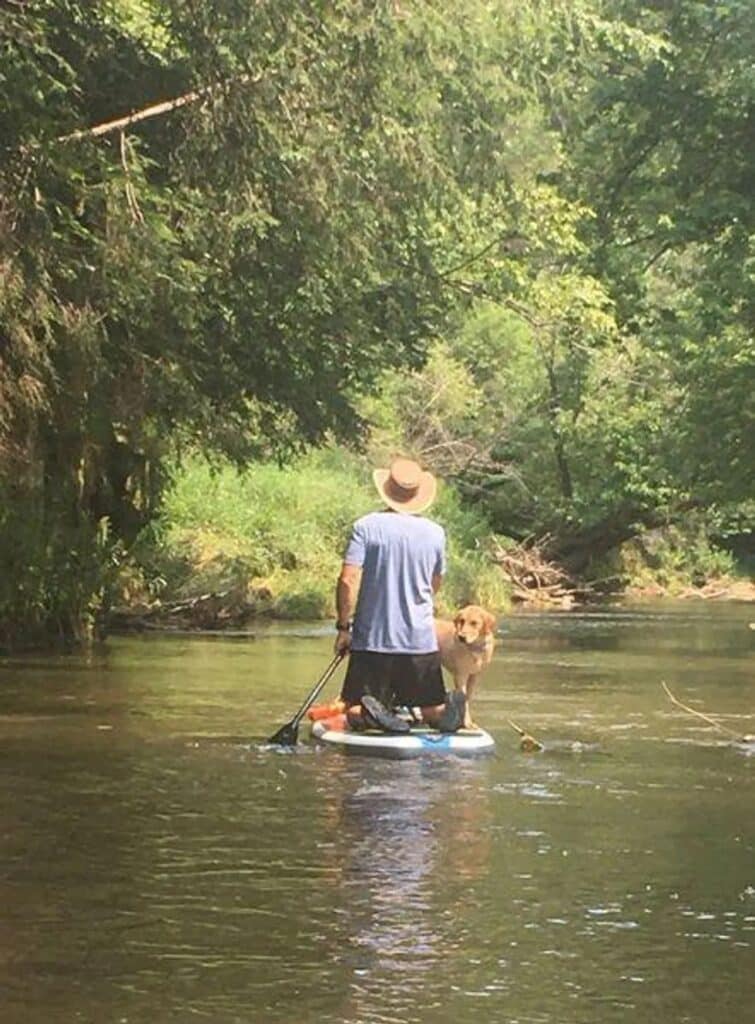
Juniper and Philip paddleboarding the Kickapoo River in southwestern Wisconsin
Photo by Sara Tedeschi
Rethinking the Human-Canine Bond
In our work, we are frequently called upon to describe the “human-animal bond,” a concept so personal and nebulous (some would even say “magical”) as to defy any clear or singular definition. At times, this elusive quality can make studying our relationships with other animals a challenge. Adding to the complexity is the common misconception that the mere presence of an animal is in and of itself positive, no matter the circumstances. For example, when describing our research into the well-being effects of human-canine bonding, we have received responses like, “Do we really need to explore whether dogs are good for us … isn’t this obvious?” At the heart of such exchanges (which almost always include heartwarming anecdotes of the person’s own dog) is the view that the power of human-canine connection is not only self-evident, but universal across time, culture, and species. More important still is the failure to entertain whether we, in fact, are good for dogs.
We know from the evidence that our interactions with dogs don’t always lead to the results we imagined. Human-canine conflicts, such as dog bites and the abusive use of dogs as threatening instruments of oppression, are often passed over in conversation, with people more inclined to focus on the rosy aspects of our connection. Depending on one’s cultural identity, environment and other factors, relationships between humans and dogs can vary greatly from Western-based conceptions. In certain countries and communities, dogs are not typically considered to be “family members.” In fact, depending on people’s beliefs or personal experiences with dogs, that concept may seem outrageous. These diverse perceptions and ways of relating with dogs should not be overlooked in discussions of human-animal bonding.
In addition, it is important to emphasize that dogs themselves are individuals, just as we are, and not every dog enjoys or is prone to seek the company of people. Many of the current human-animal bond definitions tend to overlook this diversity by essentially referring to all non-human animals as a monolith. As we all know, a dog is not a rabbit is not a human; each of us has needs and rights based on who we are as individuals and as members of a particular species (and all species have worth). For example, the way we communicate with a horse should be tailored not only to their nature as social prey mammals, but also to their individual temperament. To “horse around” with any horse like we do with dogs who thrive from active human engagement would be stressful for the animal and therefore wholly inappropriate. We must recognize the individuality of all non-human animals, and adapt our way of relating to meet their needs.
In essence, non-human animals deserve thoughtful and ethical treatment, as well as species-specific conditions under which they can flourish. According to philosopher Dr. Martha Nussbaum, all “animals have entitlements based on justice,” including the right to play, interact with a variety of species, and build loving attachments with others. For our connections with dogs to truly be “mutually beneficial,” as we and many of our colleagues champion, then we must first work to counteract the human-centric ways in which we conceptualize and speak about these relationships. First and foremost, animal well-being should be considered a vital dimension of any human-animal bond definition. Likewise, thinking of interspecies alliances in species-specific terms (i.e., human-canine bond vs. human-animal bond) may help us optimize our care for the dogs in our lives. And, instead of relying on tired adages, such as labeling dogs as “man’s best friend,” we should seriously consider how we can be better friends to them, how our friendship can only be sincere if they, too, are safe, thriving, and free to be their authentic selves.
This will and should take more hard work on our part. It is humbling to come to terms with the fact that dogs are working continuously to be “the very good boy or girl” we so easily take for granted—and we owe them the same in kind. Often, you’ll hear their love glowingly described as “unconditional,” with people (including us, at one time or another) using this perceived trait to explain the unique healing effects of human-canine interactions. And while it is true that their loyalty can feel like mother’s milk, shielding us from the shame and uncertainty that can color our everyday lives, a dog who loves us without condition actually implies an imbalanced and unhealthy relationship. As ethologist Dr. Marc Bekoff has said, “Dogs want and need much more than they usually get from us.”
As in our relationships with people, we must work to earn the trust of dogs. Their ability to safely express themselves is shaped by their background, socialization and experiences, particularly those they have with us. Below are several tangible ideas—some of which we have learned from our friends and colleagues, like Bekoff, and others that have had meaning for us personally—that we recommend as ways to enrich the kinship you share with dogs:
- Speak your dog’s love language, whether through verbal communication, mutual gaze, playful affection, and/or treats
- Show genuine interest in their life through shared adventures
- Take time to learn what matters most to them
- Respect their rituals and personalities
- Give them the freedom to explore the world as they please
- Avoid situations that trigger or cause them stress, even if that means sacrificing your own enjoyment
- Play with your dog and take them off leash whenever you can
- Offer them opportunities to engage with the sensory world
- Provide them with warmth, requited love, and variety
- Thank them daily for who they are and what they give to you
Consistently showing up in these ways for our canine companions not only creates healthy relationships, it also provides opportunities for us to be our best selves. To be kind. To be trusted. To seek equity and inclusiveness in our relationships by accepting others, despite their differences and perceived imperfections. To be everything we love most about our dogs. Frankly, when it comes to our canine friends, we have been lazy for far too long—especially in comparison to the efforts they make to authentically affiliate with us. Our lack of awareness, stubborn ego, and/or hesitation to hold a mirror to our own behavior often hinders the potential of these remarkable bonds. And, while we are always “good enough” in our dogs’ eyes, we must do better by them so that the answer to the question we have all asked—”Does my dog love me as much as I love them?”—is never in doubt. Simply put, a one-sided partnership isn’t a partnership at all; we have to do our share. If dogs see us (and we fully believe that they do), what does it mean to see them? This, above all else, is truly the “big dog story.”
References
Beetz, A., Uvnäs-Moberg, K., Julius, H., & Kotrschal, K. (2012). Psychosocial and psychophysiological effects of human-animal interactions: The possible role of oxytocin. Frontiers in Psychology, 3, 234.
Bekoff, M. (2019). Dogs, captivity, and freedom: Unleash them whenever you can. Retrieved from https://www.psychologytoday.com/us/blog/animal-emotions/201903/dogs-captivity-and-freedom-unleash-them-whenever-you-can
Clothier, S. (2005). Bones would rain from the sky: Deepening our relationships with dogs. New York, NY: Grand Central Publishing.
Institute for Human-Animal Connection. (2021). Home page. Retrieved from https://socialwork.du.edu/humananimalconnection
My Dog is My Home. (2021). Who we are. Retrieved from https://www.mydogismyhome.org/who-we-are
Nagasawa, M., Mitsui, S., En, S., Ohtani, N., Ohta, M., Sakuma, Y., Onaka, T., Mogi, K., & Kikusui, T. (2015). Oxytocin-gaze positive loop and the coevolution of human-dog bonds. Science, 348 (6232), 333–336.
Nussbaum, M. C. (2006). Frontiers of justice: Disability, nationality, species membership.
Cambridge, MA: Belknap Press of Harvard University Press.
Olmert, M. D. (2009). Made for each other: The biology of the human-animal bond. Cambridge, MA: Da Capo Press.
Porges, S. W. (2004). Neuroception: A subconscious system for detecting threats and safety. Zero to Three, 24(5), 19–24.
Shelter Animals Count. (2021). Tracking the impact of COVID-19. Retrieved from https://www.shelteranimalscount.org/news-covid-data
TED. (2021). Brené Brown: Vulnerability researcher, storyteller. Retrieved from https://www.ted.com/speakers/brene_brown
Tedeschi, P., & Jenkins, M. A. (Eds.). (2019). Transforming trauma: Resilience and healing through our connections with animals. West Lafayette, IN: Purdue University Press.
Wynne, C. D. L. (2019). Dog is love: Why and how your dog loves you. Boston, MA: Mariner Books.
subscription
LOVE, DOG

